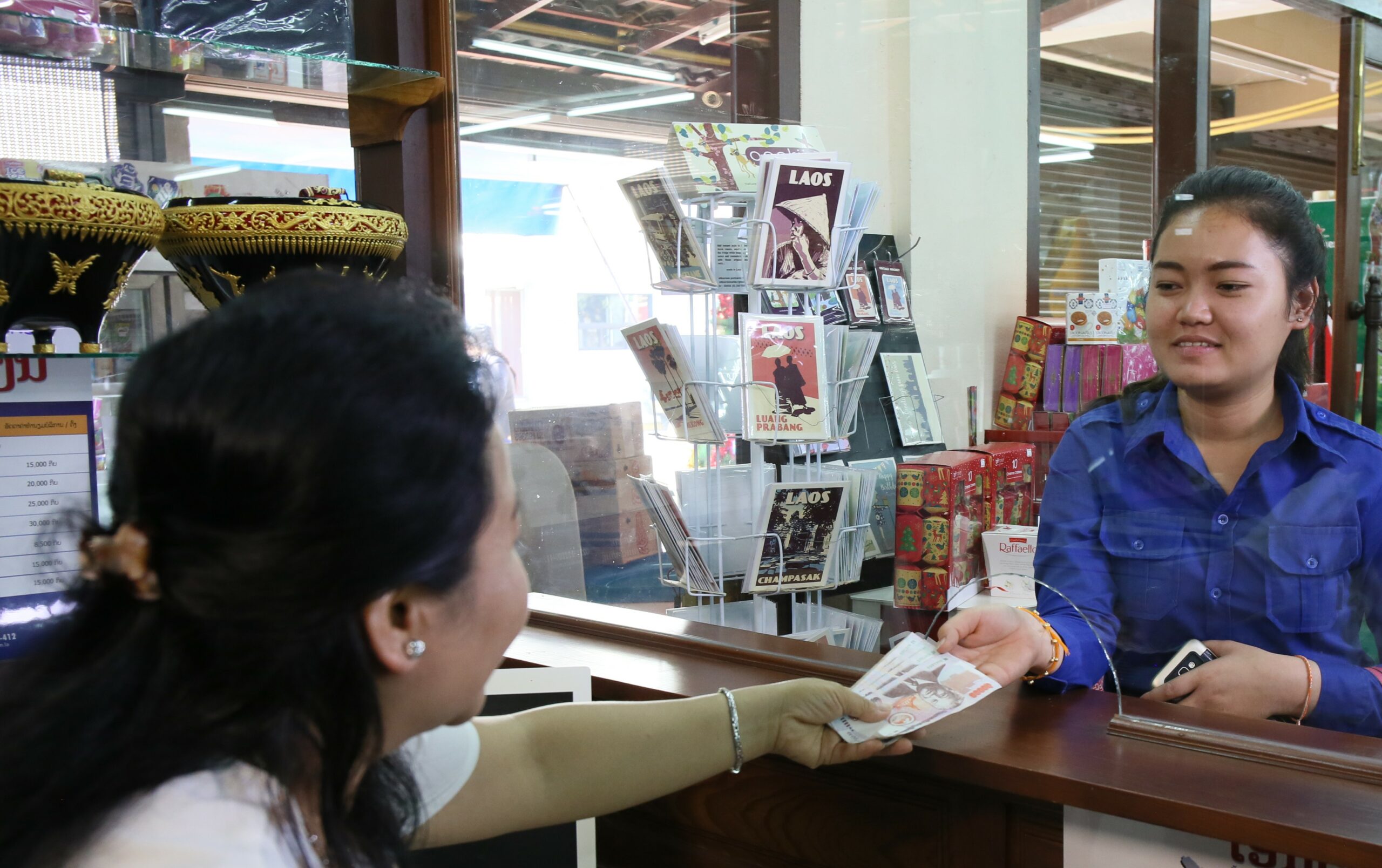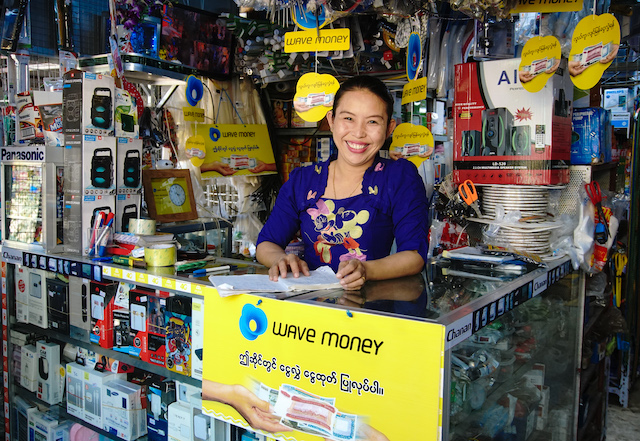Nowadays, Tim Scheffmann develops software for 900 village banks in Laos. But when explaining what originally drew him to the fintech industry in Southeast Asia, he’s quick to tell a parable about a pair of shoe salesmen.
Upon arriving in a land where the population saw little use for shoes, one salesman wrote home sadly to say there was no use setting up shop in a place with no market for his goods.
“The other one wrote back, he said: ‘This is a great market! No one wears shoes – yet,’” Scheffmann said. “The different approach to see the opportunities, this is what made me stay.”
His joke serves as an allegory for the trajectory of the banking scene in Cambodia, Myanmar and Laos over the past decade. A virtually undeveloped banking scene greeted Scheffmann when he arrived in 2012 to work in Myanmar’s nascent finance sector, but he was one of a few innovators to see potential in a mobile money market at a time when the vast majority of people in these three countries didn’t possess a traditional bank account.
To those outside the niche group of Southeast Asia’s mobile money innovators, discussing the intricacies between a PSI and a PSP can seem dry and abstract. But on the ground, the region’s poorest across Laos, Cambodia and Myanmar today now have a means to send money quickly and safely, adopting fintech that industry experts say matches or exceeds many of the services seen in the developed world.
Colourful QR payment codes have proliferated in the past decade, stuck to the windows of hole-in-the-wall fruit shops, noodle carts and shops of all kinds. Once-simple money wiring kiosks have already grown into something on par with top-level mobile banking services in a race to fill the gap in the three countries that still today have the fewest formally banked adults in Southeast Asia.
As brick-and-mortar banks run to keep up with the ever-growing number of e-wallets and transfer apps, people in the most rural parts of Southeast Asia who have long lacked access to financial services are now finding no shortage of platforms offering access to digitised remittances, bill and loan repayment and otherwise improved local cash flow — most delivered with a heavy dose of hype and the promise of bolstering their small economies.
Matthew Tippetts, founder of Clik Asia, a payment and bank security startup set to launch this summer in Cambodia, was quick to note 73% of people in ASEAN’s ten countries lack bank accounts, but nearly the same percentage own a smartphone.
He adds that digitally driven consumers are giving the global south an edge on their more developed peers.
“The amount of options for doing international remittance, and things like basically sending money to a wallet and so on, is pretty impressive compared to what you would have at home,” Tippetts said.
“You don’t really see that as being that prevalent in developed markets.”

At the end of an eight-hour bus ride from Phnom Penh lies the Cambodian town of Banlung, the capital of Ratanakiri province and home to about 30,000 people in one of the country’s most rural areas. The wide streets are lined with awnings and motorbikes, street vendors with fruit and vegetables, and a smattering of guest houses – but one blue and green front stands out.
The kiosk is a local microbranch of Cambodian banking company Wing, which, for most of its users, exists almost entirely on a mobile app supported by a network of human agents in booths like this one. The agents bridge a gap between the cash economy that still rules most of rural Cambodia and the need for digitised money services – as such, they receive and pay out in hard currency the transfers that users set up with a few swipes on a smartphone.
In this way, money can now move instantaneously across the country, most often from bustling Phnom Penh to rural hinterlands, such as that around Banlung.
They do not have to worry about losing their money or belongings like they did in the past, when they mostly asked taxi drivers for help in delivering those things
In the national capital’s Stung Meanchey district, Wing agent Sreng Sreypov opens her kiosk for the day at 7am, handling up to 500 customers in the course of a typical day. These users are stopping by to make loan payments, pay bills and send remittances to households far from the city lights.
Sreypov says the digital system is a huge improvement to how money used to be sent in Cambodia.
“They do not have to worry about losing their money or belongings like they did in the past, when they mostly asked taxi drivers for help in delivering those things,” she explained. “The taxi driver charged higher fees with no proper criteria or fixed price range.”
A solution to the problem came in the form of Australian tech entrepreneur Brad Jones, who founded Wing in 2008 when the country had little fintech and few reliable ways of sending remittances to the provinces.
Although Wing and other mobile money services have helped bridge the gap, sparse access to traditional bank branches remains the catalyst driving the mobile money movement. Only 30% of Cambodians have a bank account as of 2019, according to Wing’s deputy CEO Hor Bunthe.
“Many people still don’t have a bank account because they don’t see the need to have a bank account, or there are no financial institutions in the areas they are living,” Bunthe Hor told the Globe.
Even still, that hasn’t stopped the proliferation of microfinance loans, a form of lending once seen as a benign form of small-scale lending for development that has boomed into a Cambodian industry at the heart of a mounting personal debt crisis. As the industry continues at breakneck speeds, easy access to money and lines of credit doesn’t often come with financial literacy education. What’s more, app partnerships with microfinance institutions or other lenders might include promotions or other tactics to make taking out loans more enticing as the process becomes faster and easier.
For digital natives, whose social and consumer lives operate on their smartphones, such availability could be either risky or beneficial. Already well-accustomed to instant access, for these users it’s a small leap to expect this of their finance as well, paving the way for the growth of banking and cash transfer apps. Investment firm Mekong Strategic Partners’ senior finance manager Tola Chea says this has proved a prime demographic for growing mobile banking.
“Strong demographic growth indicators [like] young population, rapid financial sector growth, expanding internet reach and high smartphone penetration attracts many entrants to the market,” Tola said. “Technology literacy and trust is high.”
Even traditional banking has digitised to attract this demographic. When one of Cambodia’s largest banks, ABA, began to experiment with the idea of an app in 2015, its developers were shocked to discover that they needed little marketing to sell the idea to clients armed with smartphones. Hundreds of downloads snowballed into thousands, says chief digital officer Zokhir Rasulov, and today the app sits at 1.3 million downloads. Forced to play catch-up, Cambodia’s other major banks Acleda and Canadia soon began a similar mission.
Many cash transfer apps jumped on the trend, hoping to link their payment services to mobile banking. The confusion for many is in understanding how these cash apps are competing with banks, when they’re also reliant on them to survive. While most cash apps can’t hold a deposit without a bank account, these third-party apps can offer additional features on top of what the base bank account provides, like discounts, loyalty programmes, and coupons. These entice consumers to use the third-party apps as a primary means of payment for transactions, instead of their bank app QR code scanner, now prevalent around the country.
At the core of the market, this type of competition drives mobile money apps to create a one-stop shop for users and their purchases.
“At some point, we’re competitors to each other,” Rasulov admitted of ABA’s relationship with these external providers.
Even still, he says the bank has chosen to make transfers free and easy between ABA accounts and the cash apps as a selling point in the provinces, where use of such programmes is common for remittances.
“Such integration gives a win-win position to the open players,” he said.
When Scheffmann arrived in Myanmar in 2012 to work for a bank, he found the system in place a far cry from the mobile payment of today.
“Everything was on paper, everything, the accounts, if you withdraw $400 or something,” Scheffmann said. “They had one computer in this whole bank, and the manager, at that time, he was surfing Facebook.”
Recovering from 50 years in isolation, a telecommunications boom was on the horizon. One year later in 2013, the price of the SIM card dropped from thousands of dollars to just $2, meaning many consumers went straight to the smartphone.
A former banker in Myanmar said that when the economy started to boom as the country opened to the world, physical banks were quickly overwhelmed with the amount of in-person businesses and were pushed online. While the first few renditions of traditional banks KBZ and CB apps were underwhelming, the banker, who asked to go unnamed, said their developers were forced to quickly improve to compete with growing fintech.
More proverbial shoe salesmen saw opportunity in the still-opening country. Wing founder Jones reappeared in the region after leaving the company in 2010, this time founding Myanmar’s Wave Money in 2016.
“Wave Money really disrupted the banking scene, so the banks were forced to improve their mobile banking capacity,” the banker said.
The now-hugely popular transfer service has a similar agent transfer model for mobile money, which also uses in-app features to send and receive payments, pay loans and bills, and use QR code payment with vendors.
While leapfrogging was the method for success in Cambodia, in Myanmar, Jones says it was leapfrogging of entirely different proportions.
“Myanmar leap-frogged straight to 3G and 4G, and feature phones were hardly used at all,” he said.

It’s estimated that as many as 85% of Myanmar’s population is still unbanked, which the banker attributes to historic mistrust, sparse branches, and a long, arduous wait to withdraw money or do other basic tasks in person. In comparison, Wave money has 70,000 agents to perform wires covering 89% of the country.
The banker says this service where banks are physically absent is a large reason for Wave’s popularity, along with other less prominent services, like MPT Pay.
“In developed countries, you rely on the banks to develop this massive infrastructure or bank branches or these systems. But in developing countries, it’s a mobile phone,” they said.
In the last several years, large banks, like KBZ and CB, have adopted similar agent banking services like Wave Money and also used partnerships with Huawei to try to tap the 90% of the population with a smartphone.
But the February 1 coup has proven a huge financial strain on the country’s cash flow, and it seems unlikely fintech will make any large leaps while ATMs are barely dispensing cash.
“You really need political stability,” the banker said. “Even though you have the system in place, everything in place, this coup disrupted everything. And whatever you’ve worked for really just crumbled.”
As in Myanmar and Cambodia, accessing a bank branch can be a challenge for Laotians, and sometimes not even a concern for many in the heavily cash-based society. But the country is on the precipice of its own fintech growth spurt, experts say.
In 2018, Vietnamese mobile provider Unitel launched under a subsidiary its first mobile money service, an e-wallet known as U-money. The service garnered 500,000 customers by December 2020, a not insignificant portion of the national population of 7 million. But the real growth came when digital payments became a matter of public safety during the ongoing Covid-19 pandemic.
“Covid has catalysed digital payments around the world, and Laos is no exception,” said David Kleiman, a former UN Development Fund digital finances and services expert in Laos, and now a consultant for developing economies at PHB Development. “There’s been a real push.”
In 2020, the largest mobile transfer service yet was implemented by Lao Development Bank and ST Bank through a QR code, and account transfer through five additional banks in the region.
But Kleiman says it’s difficult to compare Laos’ development to any other country because of the lack of regulatory structure in the young banking sector, as well as how its motivations to grow have shaped the industry.
“They have a lot of work to do, a lot more potential,” Kleiman said. “They’re really just scratching the surface.”
Despite the growing prevalence of these apps, rural communities are driving banking sector growth on a small, but important scale.
Mobile money is not in the hands of the technically savvy. It’s in the hands of the rice farmer
Scheffmann is helping create accessible finance on a smaller scale through developing software for village banking, still in its early stages. Village banks operate out of a community building certain days of the month, allowing villagers to accrue savings and to take out microloans specific within their community.
“This community can get a loan from their own community, so that makes it more like a financial literacy programme because they have to manage both sides, the savings and the loans,” he said.
Kleiman agrees that rural communities are crucial in developing mobile money. Wiring services are heavily utilised for education and boarding, where parents bring hard cash to agents, who transfer it to children in cities to use digitally, as well as remittances which move the other way.
“[Mobile money] is not in the hands of the technically savvy,” he said. “It’s in the hands of the rice farmer.”
Each country remains at a different stage of their mobile money development – from the saturated market in Cambodia, to Myanmar’s attempt to preserve its economic gains and fintech market, as well as the very beginnings of a Laos market. But as these services become more ubiquitous in the region, they become increasingly familiar to their populations, as well.
As Sreypov wraps up her shift at the Wing kiosk in Stung Meanchey in the evening, she’s also noticed a change in her clientele’s understanding of mobile money since she began there in 2014.
“People seem to understand money wiring a lot better now compared to the past,” she said. “For the elders, they still need help regarding the process and everything. But it’s a lot better now.”


